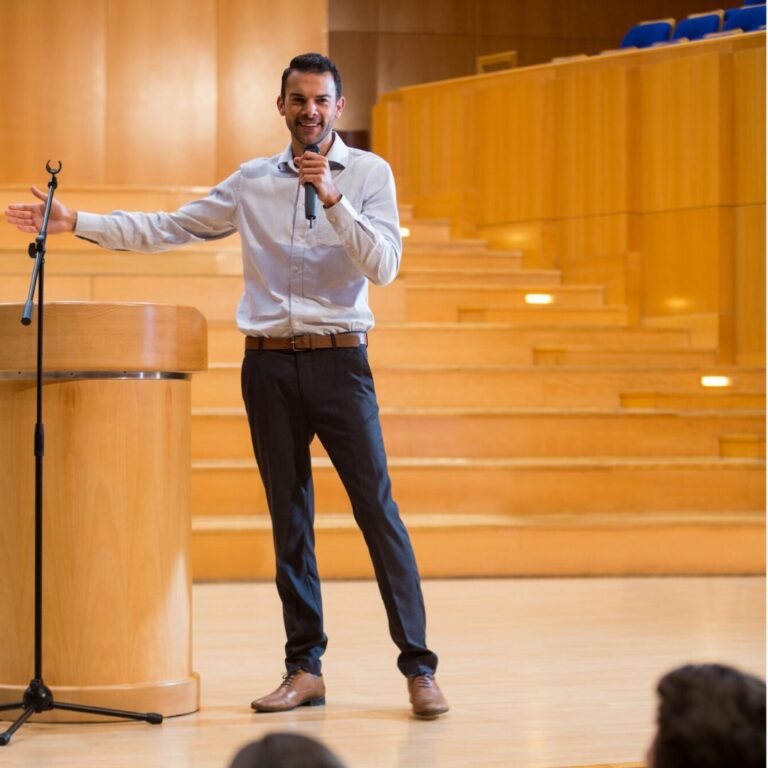
- Home
- Overcome Speed in IELTS Listening Section 4
- Priya
- 0 Comments
- February 17, 2025

Overcome Speed in IELTS Listening Section 4
IELTS Listening Section 4 is one of the most challenging parts of the test because it features a fast-paced academic lecture without any pauses. Many test-takers struggle to keep up with the speaker, missing important details or failing to complete answers in time. The speed of speech, complex vocabulary, and absence of breaks make it difficult to follow the lecture and extract key information effectively. To overcome this challenge, you must improve your listening speed, sharpen your note-taking skills, and develop strategies to stay focused throughout the section. This blog will provide essential tips to help you adjust to the fast pace of Section 4 and avoid common mistakes that lead to lost marks.
Understanding the Structure of Section 4
Why Is Section 4 So Fast?
In IELTS Listening Section 4, the speaker delivers a continuous lecture on an academic topic. Unlike other sections, where conversations or discussions allow for natural pauses, this section has no breaks to help you catch up. The lecture is designed to mimic a real university setting, where students must take notes while listening to a professor.
Types of Information Given Quickly
The lecture may include definitions, research findings, historical facts, processes, or comparisons. Some sections contain numbers, dates, or statistics, which are mentioned quickly and only once. Since you don’t get a second chance to hear the information, it’s essential to train your ears to capture details at a fast pace.
Common Mistakes Due to Speed
One of the most common mistakes test-takers make is getting stuck on a single answer and missing the next few. Because the lecture moves quickly, if you focus too much on a difficult word or phrase, you might lose track of the following sentences. Another issue is trying to write full words or sentences instead of using shorthand—this wastes time and makes it harder to keep up.
Training Your Ears for Faster Listening
Gradually Increasing Listening Speed
To adapt to the speed of IELTS Listening Section 4, start by listening to lectures or podcasts at normal speed and then gradually increase the playback speed to 1.25x or 1.5x. This trains your brain to process spoken English faster and improves your ability to catch key details. TED Talks, BBC Learning English, and university lectures are great resources for this type of training.
Focusing on Key Words Instead of Every Word
Many test-takers try to understand every single word in the lecture, which is unrealistic at high speeds. Instead, focus on key content words such as nouns, verbs, and adjectives that provide the main idea. For example, if the speaker says, “A recent study in environmental science found that urban areas experience higher temperatures than rural regions,” you should focus on the words “study, environmental science, urban areas, higher temperatures.”
Listening to Different Accents
IELTS Listening features a variety of accents, including British, American, Australian, and Canadian. Some accents may pronounce words faster or in a different style. To get comfortable with different speech patterns, listen to speakers from various English-speaking countries. Platforms like BBC, NPR, ABC Australia, and TED Talks offer exposure to multiple accents.
Mastering Quick and Effective Note-Taking
Using Abbreviations and Symbols
Writing every word in full slows you down. Instead, develop a system of abbreviations and symbols to take notes efficiently. For example:
- “govt” for government
- “env” for environment
- “↑” for increase
- “↓” for decrease
- “b/c” for because
By using shorthand, you can capture information faster and keep up with the lecture.
Writing Key Phrases, Not Full Sentences
Instead of trying to write everything word for word, note only the essential information. If the speaker says, “The study was conducted over a period of five years in 20 different cities,” you can write: “study: 5 yrs, 20 cities.” This method allows you to process information faster and avoid missing the next point.
Structuring Notes Clearly
Organizing your notes with headings and bullet points makes them easier to read when answering questions. You can divide your notes into sections such as main ideas, supporting details, and examples. When you look at your notes, they should help you locate answers quickly without confusion.
Answering Questions Accurately Under Time Pressure
Reading Questions Before Listening
You get 30 seconds to preview the questions before the lecture begins. Use this time to identify keywords and predict possible answers. Knowing what to listen for will help you stay focused and catch answers faster.
Keeping Up Without Panicking
If you miss an answer, don’t stop to think about it too long—move on to the next question. The worst thing you can do is dwell on a missed answer and lose focus on the upcoming information. Train yourself to recover quickly by practicing full-length IELTS listening tests.
Checking Spelling and Word Limits
Even if you catch the correct answer, spelling errors or exceeding the word limit can result in lost marks. For example, if the answer is “pollution control,” but the instructions say “Write NO MORE THAN ONE WORD,” then writing both words would be incorrect. Always double-check word limits when transferring answers.
Practicing Smartly for Faster Listening
Using IELTS Listening Practice Tests
To build confidence, practice with official IELTS listening tests under timed conditions. Pay attention to how information is structured in Section 4 lectures and get used to the fast pace. Analyze your mistakes to identify areas for improvement.
Shadowing Technique for Speed Improvement
One effective way to improve listening speed is the shadowing technique. Listen to a lecture and try to repeat what the speaker says in real time. This trains your brain to process spoken English quickly and improves your ability to recognize key information instantly.
Improving Note-Taking Skills
In addition to IELTS tests, expose yourself to real university lectures, educational documentaries, and expert talks. This will familiarize you with the academic vocabulary and fast-paced speech patterns commonly used in Section 4. Websites like Coursera, Open University, and edX offer free academic lectures that are perfect for this purpose.
Conclusion
Mastering fast-paced listening in IELTS Section 4 requires a combination of active listening, effective note-taking, and smart practice strategies. By gradually increasing your listening speed, focusing on key words, and practicing with real academic lectures, you can train yourself to keep up with the fast pace of the test. Developing a strong shorthand system and staying calm under pressure will further improve your ability to answer questions accurately. With regular practice, you will gain the skills needed to overcome speed challenges and achieve a high IELTS Listening score!
Section Title
Confidence Exercises for English Speaking Speaking English confidently can be a challenge for many...
Tips for Confident English Conversations Speaking English with confidence is essential for effective...
Overcome Fear of Speaking English Enhance your English communication skills to impress clients and...
Impress Clients with English Communication Enhance your English communication skills to impress...
Ace Job Interviews with Business English Boost your confidence and excel in job interviews with...
Negotiate Successfully in Business English Master the art of negotiation in Business English! Learn...
Network Effectively with Business English Learn to network effectively using Business English!...
Polish English for Presentations Delivering a presentation in English requires clarity, confidence...
Key Business English Phrases for Professionals Effective communication in the business world...










Leave a Comment